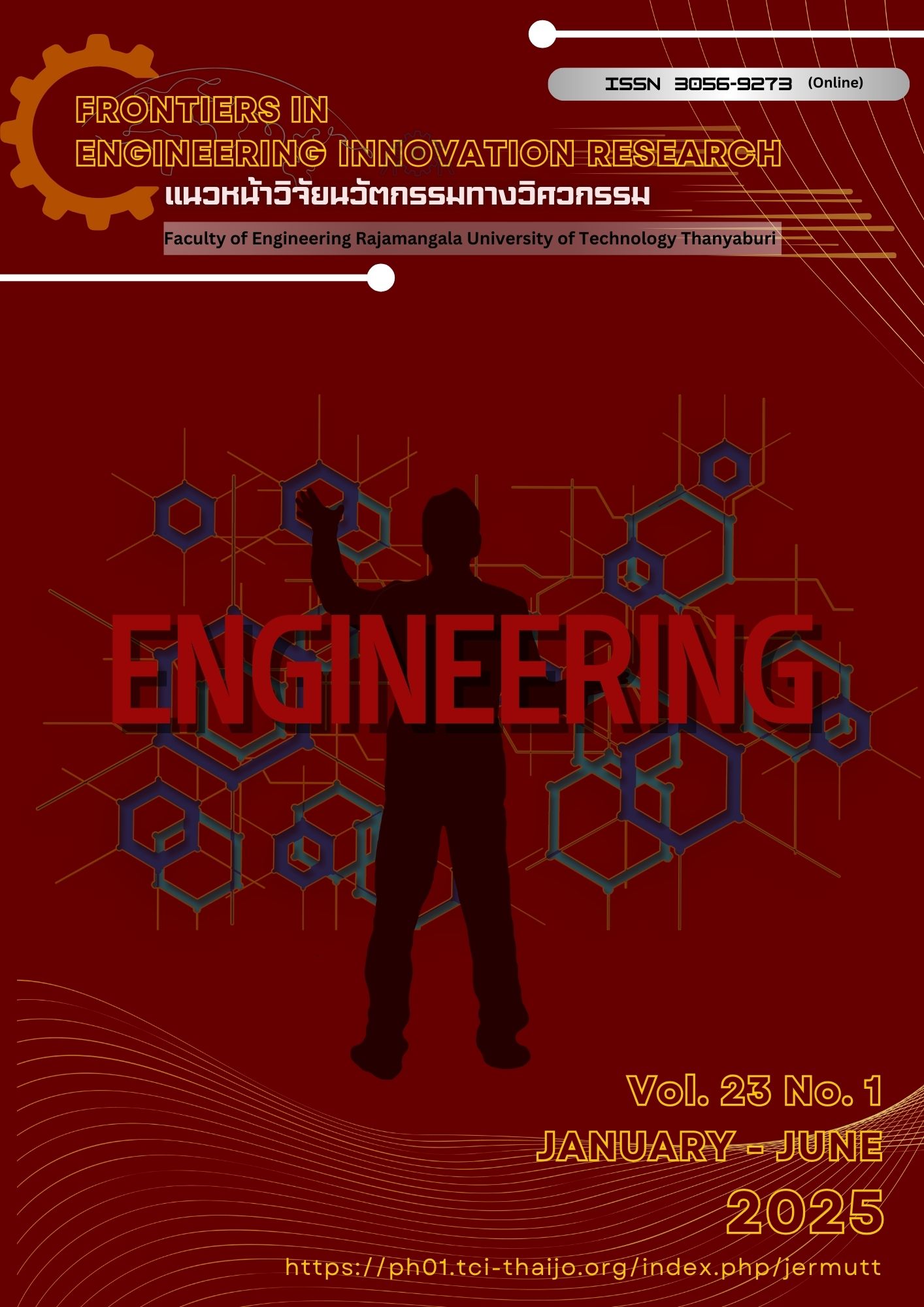The development of particleboard from oil palm fronds for reducing the agricultural wastes
Main Article Content
Abstract
This research aims to develop particleboard from oil palm frond wastes for household items and souvenirs. The study designs 10 different ratios of oil palm frond wastes mixed with Methylene Diphenyl Diisocyanate (pMDI), forming particleboards with dimensions of 15 x 17.5 cm and a thickness of 5 mm. These boards are pressed at a temperature of 150°C for 7 minutes. Tests are conducted according to the Thai Industrial Standard (TIS 876-2547) for flat particleboards. The test results indicate that the optimal particleboard for household and souvenir products is the board with a controlled density of approximately 650 kg/m³, mixed with 0.11 parts by weight of pMDI and 1 part by weight of ground oil palm frond wastes. This particleboard has a density of 600.50 kg/m³, moisture content of 4.52%, thickness swelling of 4.61%, water absorption of 45.23%, bending strength of 6.28 MPa, modulus of elasticity of 478.75 MPa, and tensile strength perpendicular to the surface of 0.38 MPa.
Article Details

This work is licensed under a Creative Commons Attribution-NonCommercial-NoDerivatives 4.0 International License.
The manuscript, information, content, picture and so forth which were published on Frontiers in engineering innovation research has been a copyright of this journal only. There is not allow anyone or any organize to duplicate all content or some document for unethical publication.
References
Office of Agricultural Economics. Palm oil [Internet]. 2024 Mar [cited 2024 Mar 17]: [about 1 p.]. Available from: https://www.oae.go.th/ (in Thai)
Bangkokbiznews. From corn to palm oil, same cause [Internet]. 2019 Oct [cited 2024 Mar 17] [about 1 p.]. Available from: https://www.bangkokbiznews.com/lifestyle/1286/ (in Thai)
Kerprasit P, Jaralworakulwong A, Plitsiri I. Development of artificial wood panels from recycled bioplastic mixed with coconut shell power. VRU Research and Development Journal Science and Technology. 2024;19(2):136–50. (in Thai)
Jarunjaruphat N, Acharry S. The particleboard manufacturing from agricultural waste. The Journal of KMUTNB. 2018;28(2):469-76. (in Thai)
Konisranukul W, Tuaycharoen N, Soratron S. Development particleboard for interior wall panel building from hemp woody core. Journal of Building Energy & Environment. 2019;2(2):78-96. (in Thai)
Phlansaeng T, Techa P, Jaiwisan C, Inthang N, Siriprachot O. Study on the manufacturing wood substituted materials from agricultural waste. PSRU Journal of Science and Technology. 2021;6(3):121-34. (in Thai)
Thai Industrial Standards Institute (TISI). Thai industrial standard no.876-2004: particleboard product. Bangkok: TISI; 2004. (in Thai)
Yenjai P, Charusombat S, Weenin T. Particleboard manufacturing from waste of cajuput (melaleuca cajuputi powell). VRU Research and Development Journal Science and Technology. 2016;11(2):131-40. (in Thai)
Kerprasit P, Weeranukul P, Weeranukul I, Suweero K, Muangprab K. Development of particleboard from northern black wattle tree bark for using as decorative materials. Journal of Engineering, RMUTT. 2021;19(1):125-35. (in Thai)
Cheng X, He X, Xie J, Quan P, Xu K, Li X, Cai Z. Effect of the particle geometry and adhesive mass percentage on the physical and mechanical properties of particleboard made from peanut hull. Bio Resources. 2016;11(3):7271-81.
Nemli G, Örs Y, Kalaycıoğlu H. The choosing of suitable decorative surface coating material types for interior end use applications of particleboard. Construction and Building Materials. 2005;19(4):307-12.
Bledzki AK, Gassan J. Composites reinforced with cellulose based fibers. Progress in Polymer Science. 1999;24(2):221-74.
Sekaluvu L, Tumutegyereize P, Kiggundu N. Investigation of factors affecting the production and properties of maize cob-particleboards. Waste and biomass valorization. 2014;5:27-32.
Hazrat BM, Zarea HH, Daliri SM, Abginechi Z, Hemmati A. Mechanical and insulating performances of ultralight thick particleboard from sugarcane residues and woods planer shaving. Eur. J. Wood Prod. 2016;74:161-8.


